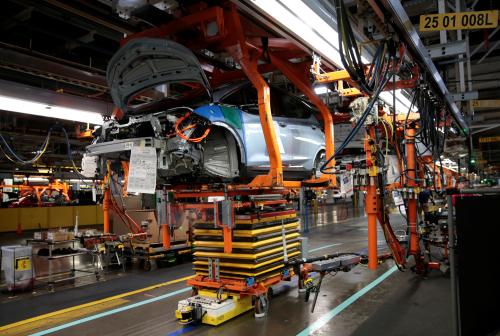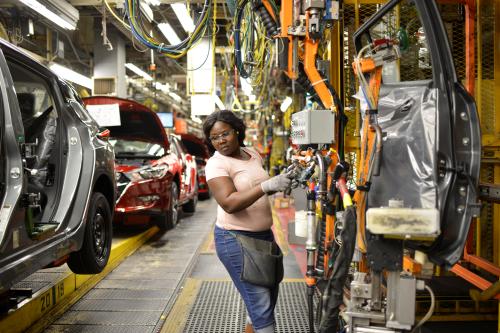How will technological change affect the quantity and quality of future jobs? It is difficult to know. The issue of whether there will be enough jobs in the future receives substantial attention, mainly because of the well-publicized experiences of manufacturing workers whose jobs have been displaced by the introduction of robotics. It also reflects a long-held societal anxiety that machines will replace us.
The consensus among most scholars, however, is that jobs are not going away. Hence, rather than quantity of jobs, our focus should be on improving the quality of those jobs generated in a future governed by technological change. That is, more effort should be directed toward making proper investments in training and education and adopting policies that will improve labor market institutions to ensure the jobs of the future pay well and provide employment security to workers. Attaining this goal will be key to maintaining and growing the middle class in the future.
How jobs are changing
Most occupations are expected to change in response to advances in automation and artificial intelligence (AI) protocols, but it is difficult to predict how. The existing empirical evidence, however, suggests that the jobs most at risk of substantial revision are those whose constituent tasks are sufficiently routine and structured to make them amenable to substitution by digital technologies.
We can see glimpses of this future by observing changes in the skills required by employers seeking new workers. In a recent paper by IBM Research and the MIT-IBM Watson AI Lab[1], the authors study online job listings data collected by Burning Glass Technologies, a job analytics firm, to examine how skill requirements in these listings changed over the period spanning 2010-2017. The authors’ findings suggest that tasks that are more suitable for machine learning and AI algorithms such as scheduling and credential validation fell over the observation period.
At the same time, the authors found that listings featuring tasks that require human judgment, discretion, and other so-called “soft skills” became more common. More importantly, this latter skill set was associated with higher listed salaries, suggesting that these skills were becoming more valuable in the market, especially in occupations that combine technical and soft skills. This finding is in line with published academic research using data on employment and skills by David Deming (2017). Deming finds that jobs where social skills were a primary requirement increased substantially between 1980 and 2012; employment and wage growth was especially strong in occupations where math ability and social skills were complements.
While these job listings data do not ultimately tell us much about what workers ultimately do, nor, because of their methodology, say much about less remunerated jobs such as personal care work, this research does identify some important dynamic features of these labor markets. First, while jobs are changing due to technological adoption, they are changing relatively slowly, and, notwithstanding the special case of industrial robots in large manufacturing plants, there is little evidence of wholesale displacement in other sectors. In addition, they also suggest the speed and scope of change at this point may allow us, as a nation, to make choices that better prepare workers for the labor market of the future.
Investing for the future of work
How do we use this information to help match workers with quality jobs? Foremost, we need to provide better education and training models so that both current and future members of the workforce can acquire and develop skills that better complement technological change. Workers without college educations will likely bear a disproportionate burden of technological change in labor markets and many will require reskilling and retraining. However, as noted by MIT’s Paul Osterman at a recent conference hosted by the Future of Middle Class Initiative, the current education and training system in the US is a largely unstructured mix of 4-year colleges and universities, community colleges, vocational schools, workforce training and apprenticeship programs, and a “wild west” of other training platforms like bootcamps. The lack of coherence in this sector makes it difficult for people—especially those following less traditional post-secondary pathways—to make good choices given limited budgets and busy schedules. In addition, limited information about quality and whether program curricula fit the needs of local employers can raise the risk of investing in this type of training for workers.
Policymakers at the federal, state, and local levels can help. Committing to investments aimed at standardizing this training system—particularly through the community college system—should be a first-order concern given their affordability, their broad geographic reach, existing infrastructure, and the large number of students that already attend. Community colleges can potentially serve as a locus for public-private partnerships that can ensure that attendees match their training to skills demanded by employers, and potentially provide support for connecting workers with other types of training programs such as apprenticeships. Of course, not every worker can spare the time or expense to take community college classes. Ensuring the availability of training options that both provide skills and credentialing in areas that fit employer needs through online platforms and on-the-job models that connect better to employer needs will be key to helping relatively older workers to compete for better jobs in the labor markets of the future.
Improving the education and training options for workers is only one component of the systemic changes needed to help workers navigate the labor market and attain quality jobs in the future work environment. As a recent report by the MIT Task Force on the Work of the Future outlines, fostering a system that helps workers achieve quality jobs in the future will also require efforts to change other labor market institutions to better benefit workers. Their suggestions to improve outcomes for workers include:
- Valuing human capital in the tax code. The tax code favors investments in physical capital over human capital through subsidies for capital expenditure, depreciation schedules, and imposing low rates on the returns to capital investments. Policymakers can potentially mitigate this imbalance by providing more incentives for investments in worker training, especially in areas where workers would receive credentials.
- Incentivizing innovation that enhances complementarity not substitution. Subsidies and other incentives should be shifted towards supporting innovation that complements and augments worker efforts, making them more productive. This includes supporting investments in management capacity that will help firms know how to better integrate their workforce and investments in technology.
- Reintroduce workers as stakeholders. The merits of pure shareholder capitalism in the US are currently under litigation by many scholars—my colleagues Richard Reeves and Isabel Sawhill included—in part because the system fails to account for the social costs imposed by its imperatives on workers and communities. This occurs partly because of the decline in private sector unions; workers rarely have a seat at the table. Pushing firms to reevaluate their institutional imperatives, coupled with more worker representation in decision processes, may potentially help contribute to workers sharing more in the benefits associated with increased productivity and increased economic dynamism that is promised by advances in technology and AI.
Ensuring a middle class in the future
We are unlikely to observe the end of work any time soon. However, access to quality jobs that maintain or support upward mobility into the middle class will depend on the steps taken now. As the technology underlying automation, digitization, and AI advances, many middle-class workers will be at risk of the consequences of labor market disruption. Investments that help workers enhance their skills and facilitate shared prosperity between workers and firms through improved labor market institutions should each be a part of the discussion going forward.
[1] Disclosure: IBM provides support to the Future of Middle Class Initiative.
The Brookings Institution is committed to quality, independence, and impact.
We are supported by a diverse array of funders. In line with our values and policies, each Brookings publication represents the sole views of its author(s).







Commentary
How automation could make some jobs better
November 21, 2019